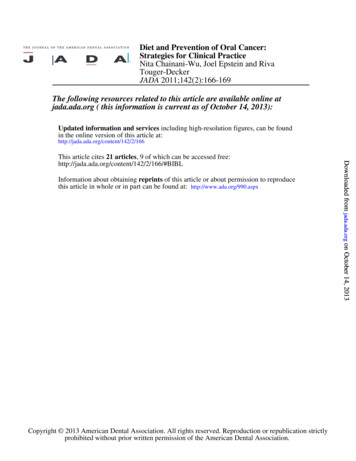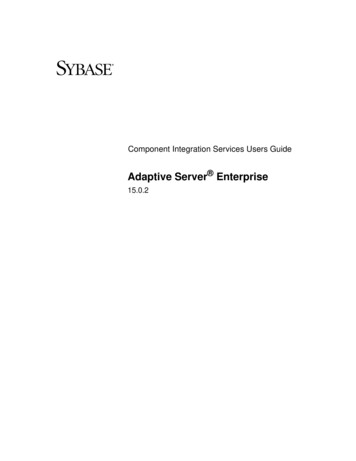
Transcription
Diet and Prevention of Oral Cancer:Strategies for Clinical PracticeNita Chainani-Wu, Joel Epstein and RivaTouger-DeckerJADA 2011;142(2):166-169The following resources related to this article are available online atjada.ada.org ( this information is current as of October 14, 2013):Updated information and services including high-resolution figures, can be foundin the online version of this article n about obtaining reprints of this article or about permission to reproducethis article in whole or in part can be found at: http://www.ada.org/990.aspxCopyright 2013 American Dental Association. All rights reserved. Reproduction or republication strictlyprohibited without prior written permission of the American Dental Association.Downloaded from jada.ada.org on October 14, 2013This article cites 21 articles, 9 of which can be accessed free:http://jada.ada.org/content/142/2/166/#BIBL
CLINICALPRACTICENUTRITIONDiet and prevention of oral cancerStrategies for clinical practiceNita Chainani-Wu, DMD, MS, PhD; Joel Epstein, DMD, MSD, FRCD(C), FDS RCS(E);Riva Touger-Decker, PhD, RD, FADAore than 400,000 cases of oral andpharyngeal cancer (OPC) occurannually worldwide, and OPC isamong the most common cancers.1In the United States, it is estimated thatapproximately 36,500 new cases and 7,800deaths resulting from OPC will have occurredin 2010.2 More than 90 percent of oral cancersare squamous cell carcinomas. Prevention ofthese cancers in dental practice settings hasfocused mainly on early detection of oral premalignant mucosal changes.3According to the American Cancer Society,4“[e]vidence suggests that one-third of the morethan 500,000 cancer deaths that occur in theUnited States each year can be attributed todiet and physical activity habits includingoverweight and obesity.” Investigators in epidemiologic studies consistently have found ahigh intake of fruits and vegetables to be protective against OPC, as well as cancer occurring at other sites, including the esophagus,breast, prostate, lung, bladder and colon.5-7Our report provides an introduction to the relationship between diet and OPC, and we presentrecommendations for the primary prevention ofOPC through the use of dietary guidelines. InMAB STRACTBackground. Oral health care professionals canplay an important role in preventing oral cancer byperforming oral mucosal examinations to detect precancerous changes and by educating patients aboutoral cancer prevention strategies, including dietaryapproaches.Conclusions. Current evidence supports a diethigh in fruits, vegetables and plant-based foods forprevention of oral cancer. Dietary supplements—including vitamins and minerals—have not beenshown to be effective as substitutes for a diet high infruits and vegetables.Clinical Implications. In addition to discussingtobacco and alcohol use with patients (and, if relevant, betel nut and gutka consumption), as well asthe risk of sexual transmission of human papillomavirus, clinicians should provide dietary advice forthe prevention of oral cancer as part of routinepatient education practices.Key Words. Diet; cancer; mouth neoplasms;nutrition; oral cancer.JADA 2011;142(2):166-169.Dr. Chainani-Wu is a health sciences assistant clinical professor, Department of Orofacial Sciences, School of Dentistry, University of California,San Francisco, and is in private practice in Mountain View, Calif. Address reprint requests to Dr. Chainani-Wu at 100 W. El Camino Real, Suite 76,Mountain View, Calif. 94040, e-mail “nita.wu@ucsf.edu”.Dr. Epstein is a professor, Department of Oral Medicine, College of Dentistry, and Department of Otolaryngology—Head and Neck Oncology and CancerCenter, College of Medicine, University of Illinois at Chicago.Dr. Touger-Decker is a professor and the chair, Department of Nutritional Sciences, School of Health Related Professions, and the director, Division ofNutrition, New Jersey Dental School, University of Medicine and Dentistry of New Jersey, Newark.166JADA 142(2)http://jada.ada.orgFebruary 2011Copyright 2011 American Dental Association. All rights reserved.
CLINICALaddition, we present patient education strategies.MECHANISMS BEHIND THERELATIONSHIP BETWEEN DIETAND CANCERPRACTICENUTRITIONBOX 1Recommendations for prevention of cancer.*BODY FATdBe as lean as possible within the normal range of body weightPHYSICAL ACTIVITYThe mechanisms by which diet maydBe physically active as part of everyday lifeinfluence cancer risk, including OPCFOODS AND DRINKS THAT PROMOTE WEIGHT GAINdLimit consumption of energy-dense foods and sugary drinksrisk, are understood only partially.PLANT FOODS†The process of carcinogenesis may beEat mostly foods of plant origindinitiated by damage to cellular DNA.ANIMAL FOODS†Various exposures, including those todLimit intake of red meat and avoid processed meatfree oxygen radicals and chemicalsALCOHOLIC DRINKS†such as nitrosamines, can damageLimit intake of alcoholic drinksdDNA.7 Accumulation of mutations,PRESERVATION, PROCESSING AND PREPARATION†particularly in genes involved in celldLimit consumption of salt; avoid moldy cereals (grains) and pulses (legumes)division, DNA repair and apoptosis,DIETARY SUPPLEMENTS†dAim to meet nutritional needs through diet alone; dietary supplements arecan result in changes that may leadnot recommended for cancer preventionto carcinogenesis.7BREASTFEEDING‡Certain compounds in food maydMothers should breastfeed and children should be breastfedbe protective against cancer. ForCANCER SURVIVORSexample, vitamins C and E havedFollow the recommendations for cancer preventionantioxidant properties and may prevent DNA damage by reducing expo* Adapted with permission from the World Cancer Research Fund, American Institutefor Cancer Research, Washington.7sure to free radicals of oxygen; ter† Studies have been conducted of these exposures, with oral cancer as the outcome,penes, which are a group of compoundsand findings have been consistent with these recommendations.‡ Women who have a history of breastfeeding their children are at a lower risk ofpresent mainly in certain plants suchdeveloping breast cancer and possibly ovarian cancer. In addition, there are numerousas citrus fruits, can influence cellshort- and long-term health benefits to the breastfed child. Therefore, any recommencycle progression and induce apopdations by dentists regarding the prevention of dental caries in breastfed children8should focus on initiation and maintenance of good oral hygiene in the child and nottosis. Fruits and vegetables containdiscourage continued breastfeeding.numerous other known and unknownmicronutrients, collectively termed“phytonutrients” (organic components present inlarly citrus fruits, in the prevention of oralplant foods thought to have nutrientlikecancer. In a cohort study of risk factors foractions), which may act synergistically to presecond primary cancers in patients with a hisvent cancers including OPC.5,7 Other food compotory of OPC, Day and colleagues11 also found anents, such as nitrites in processed meats, whichprotective effect of fruit and vegetable consumpmay form carcinogenic nitrosamines, maytion. In addition, Maserejian and colleagues127increase the risk of developing cancer. Adoptionfound fruit consumption to be protective againstof a diet rich in plant foods (such as wholeoral premalignant lesions.grains, legumes, nuts, fruits and vegetables) hasResearchers have found that consumption ofbeen shown to increase the intake of protectivesalted meat,13 processed meat14 and animal fat15dietary factors, including antioxidant vitamins,increases the risk of developing oral cancer. Thecarotenoids, lycopene and fiber, while decreasingresults of a study conducted by Peters and colthe intake of pathogenic dietary factors,leagues15 showed that high consumption of dairyincluding total fat, saturated fat and animalproducts is a risk factor for head and neck squaprotein and nitrates.7,9mous cell cancers.These results suggest that a diet high inDIET AND CANCERfruits and vegetables protects against OPC, andFruits and vegetables are the food groups evaluthey are consistent with research findingsated most extensively in relation to oral cancerregarding diet and the risk of developing otherrisk, with researchers’ conducting more thancancers (Box 17). Researchers5-7 have shown that40 epidemiologic studies in various parts of thefruit and vegetable consumption has protectiveworld during the past five decades. Investigaeffects against cancers at other sites, includingtors in systematic reviews5,6 and in a metaanalysis10 have identified strong evidence of theABBREVIATION KEY. OHCP: Oral health care profesprotective role of vegetables and fruits, particusional. OPC: Oral and pharyngeal cancer.JADA 142(2)http://jada.ada.orgCopyright 2011 American Dental Association. All rights reserved.February 2011 167
CLINICALPRACTICENUTRITIONdAmerican Dietetic Association—Nutrition Fact /hs.xsl/nutrition 350 ENU HTML.htm”cancer prevention. Thiseducation is particularlyimportant for patients atan increased risk of developing OPC, includingthose who use tobacco orhave a history of tobaccouse or who consumealcohol, betel nut orgutka; those with oralpremalignant conditionssuch as leukoplakia, erythroplakia, submucousfibrosis or lichen planus24;and those with a historyof head and neck or upperaerodigestive tractcancers.As part of their routine education practices,OHCPs also should provide patients withdietary advice for theprevention of oral cancer.Box 2 provides resourcesfor OHCPs to use withpatients.dAmerican Institute for Cancer Research—Reduce Your Cancer Risk, Diet—What We Eat:“www.aicr.org/site/PageServer?pagename reduce diet home”CONCLUSIONBOX 2Strategies for addressing dietary approaches to riskreduction for oral and pharyngeal cancer.DETECTdOral premalignant mucosal changes or conditions such as leukoplakia, erythroplakia,submucous fibrosis or lichen planusdOther risk factors, including current tobacco use or history of tobacco use; alcohol, betelnut or gutka consumption; poor diet; and human papillomavirus infectionINFORMdWith a diet rich in fruits, vegetables and whole grains, you can make positive strides toreduce your risk of developing cancers of the oral cavitydDietary supplements consisting of vitamins, minerals and other bioactive compoundsin the absence of deficiencies should not be used as a substitute for fruit and vegetableconsumptionEDUCATEdDiets rich in fruits, vegetables and whole grains can contribute to a reduced risk ofdeveloping oral cancersdDietary supplements have not been shown to have the same effect on cancer riskreduction as has dietary intake of fruits and vegetablesPROVIDEdReferrals to registered dietitians for medical nutritional therapy as appropriatedResources to help patients make positive lifestyle changes to reduce their risk ofdeveloping cancerdAmerican Cancer Society—Stay cer-questions”Evidence supports a recommendation of a dietrich in fresh fruits andvegetables as part of adNational Cancer Institute: “www.cancer.gov”whole-foods, plant-baseddNutrition.gov—Smart Nutrition Starts Here: “www.nutrition.gov”diet, with limited condUniversity of Medicine & Dentistry of New Jersey Institute for Nutrition Interventions—Health and Wellness Site: .htm”sumption of meat, particularly processed meat.However, use of dietarythe esophagus, breast, prostate, colon, bladdersupplements (including vitamins, minerals andand lung. Increased intake of dietary fiber hasother bioactive compounds) in the absence ofbeen found to be protective against colondeficiencies has not been shown to confer thecancer,7 and intake of red and processed meatsame benefits as those of fruits and vegetables,has been found to be a risk factor for colonand patients should not use them as a substicancer, lung cancer, pancreatic cancer, stomachtute for fruit and vegetable consumption.7,25 cancer, prostate cancer and death due toDisclosure. None of the authors reported any disclosures.cancer.16-20 High intake of dairy products hasbeen associated with an increased risk of develNutrition is published in collaboration with the Nutrition Researchoping prostate cancer21,22 and ovarian cancer.23Scientific Group of the International Association for DentaldCenters for Disease Control and Prevention: “www.fruitsandveggiesmatter.gov/”dHarvard School of Public Health—The Nutrition ex.html”Research.RECOMMENDATIONS FOR ORAL HEALTHCARE PROFESSIONALSOral health care professionals (OHCPs) can playan important role in preventing OPC throughscreening and education. In addition to performing thorough head and neck and oralmucosal examinations to identify precancerouschanges, they should educate patients about oral168JADA 142(2)http://jada.ada.org1. World Health Organization, International Agency for Researchon Cancer. Globocan 2008: cancer incidence and mortality worldwidein 2008—the Globocan project. “http://globocan.iarc.fr/”. AccessedJan. 10, 2011.2. National Cancer Institute. Surveillance Epidemiology and EndResults. SEER Cancer Statistics Review 1975-2007. tml”. Accessed Dec. 29, 2010.3. Cruz GD, Ostroff JS, Kumar JV, Gajendra S. Preventing anddetecting oral cancer: oral health care providers’ readiness to providehealth behavior counseling and oral cancer examinations. JADAFebruary 2011Copyright 2011 American Dental Association. All rights reserved.
CLINICAL2005;136(5):594-601.4. Kushi LH, Byers T, Doyle C, et al. American Cancer SocietyGuidelines on Nutrition and Physical Activity for Cancer Prevention:reducing the risk of cancer with healthy food choices and physicalactivity (published correction appears in CA Cancer J Clin 2007;57[1]:66). CA Cancer J Clin 2006;56(5):254-281.5. Chainani-Wu N. Diet and oral, pharyngeal, and esophagealcancer. Nutr Cancer 2002;44(2):104-126.6. Block G, Patterson B, Subar A. Fruit, vegetables, and cancerprevention: a review of the epidemiological evidence. Nutr Cancer1992;18(1):1-29.7. World Cancer Research Fund, American Institute for CancerResearch. Food, Nutrition, Physical Activity, and the Prevention ofCancer: A Global Perspective. Washington: World Cancer ResearchFund, American Institute for Cancer Research; 2007. “www.dietandcancerreport.org”. Accessed Dec. 29, 2010.8. Greenwald P, Clifford CK, Milner JA. Diet and cancer prevention. Eur J Cancer 2001;37(8):948-965.9. Dewell A, Weidner G, Sumner MD, Chi CS, Ornish D. A verylow-fat vegan diet increases intake of protective dietary factors anddecreases intake of pathogenic dietary factors. J Am Diet Assoc 2008;108(2):347-356.10. Pavia M, Pileggi C, Nobile CG, Angelillo IF. Association betweenfruit and vegetable consumption and oral cancer: a meta-analysis ofobservational studies. Am J Clin Nutr 2006;83(5):1126-1134.11. Day GL, Shore RE, Blot WJ, et al. Dietary factors and secondprimary cancers: a follow-up of oral and pharyngeal cancer patients.Nutr Cancer 1994;21(3):223-232.12. Maserejian NN, Giovannucci E, Rosner B, Zavras A, JoshipuraK. Prospective study of fruits and vegetables and risk of oral premalignant lesions in men. Am J Epidemiol 2006;164(6):556-566.13. De Stefani E, Oreggia F, Ronco A, Rivero S, et al. Salted meatconsumption as a risk factor for cancer of the oral cavity andpharynx: a case-control study from Uruguay. Cancer Epidemiol Biomarkers Prev 1994;3(5):381-385.14. Levi F, Pasche C, Lucchini F, Bosetti C, La Vecchia C. Processedmeat and the risk of selected digestive tract and laryngeal neoplasmsPRACTICENUTRITIONin Switzerland. Ann Oncol 2004;15(2):346-349.15. Peters ES, Luckett BG, Applebaum KM, Marsit CJ, McCleanMD, Kelsey KT. Dairy products, leanness, and head and neck squamous cell carcinoma. Head Neck 2008;30(9):1193-1205.16. Cross AJ, Leitzmann MF, Gail MH, Hollenbeck AR, SchatzkinA, Sinha R. A prospective study of red and processed meat intake inrelation to cancer risk. PLoS Med 2007;4(12):e325.17. Sinha R, Park Y, Graubard BI, et al. Meat and meat-relatedcompounds and risk of prostate cancer in a large prospective cohortstudy in the United States. Am J Epidemiol 2009;170(9):1165-1177.18. Larsson SC, Wolk A. Meat consumption and risk of colorectalcancer: a meta-analysis of prospective studies. Int J Cancer 2006;119(11):2657-2664.19. Nothlings U, Wilkens LR, Murphy SP, Hankin JH, HendersonBE, Kolonel LN. Meat and fat intake as risk factors for pancreaticcancer: the multiethnic cohort study (published correction appears inJ Natl Cancer Inst 2006;98[11]:796). J Natl Cancer Inst 2005;97(19):1458-1465.20. González CA, Jakszyn P, Pera G, et al. Meat intake and risk ofstomach and esophageal adenocarcinoma within the EuropeanProspective Investigation Into Cancer and Nutrition (EPIC). J NatlCancer Inst 2006;98(5):345-354.21. Snowdon DA, Phillips RL, Choi W. Diet, obesity, and risk offatal prostate cancer. Am J Epidemiol 1984;120(2):244-250.22. Graham S, Haughey B, Marshall J, et al. Diet in the epidemiology of carcinoma of the prostate gland. J Natl Cancer Inst1983;70(4):687-692.23. Larsson SC, Orsini N, Wolk A. Milk, milk products and lactoseintake and ovarian cancer risk: a meta-analysis of epidemiologicalstudies. Int J Cancer 2006;118(2):431-441.24. van der Waal I. Potentially malignant disorders of the oral andoropharyngeal mucosa: terminology, classification and present concepts of management. Oral Oncol 2009;45(4-5):317-323.25. Huang HY, Caballero B, Chang S, et el. Multivitamin/MineralSupplements and Prevention of Chronic Disease. Rockville, Md.:Agency for Healthcare Research and Quality; 2006. AHRQ publication 06-E012.JADA 142(2)http://jada.ada.orgCopyright 2011 American Dental Association. All rights reserved.February 2011 169
Mountain View, Calif. 94040, e-mail “nita.wu@ucsf.edu”. Dr. Epstein is a professor, Department of Oral Medicine, College of Dentistry, and Department of Otolaryngology—Head and Neck Oncology and Cancer Center











